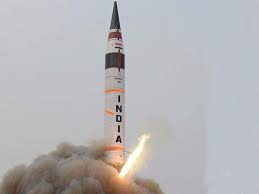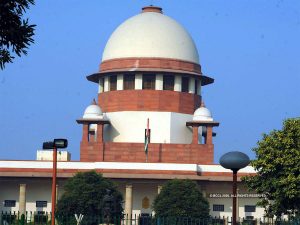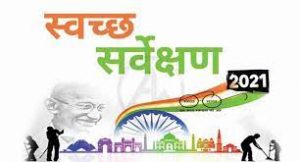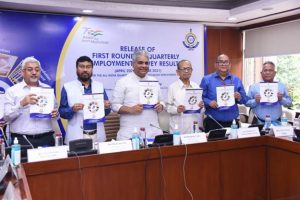Today Current Affairs: 29th September 2021 for UPSC IAS exams, State PSC exams, SSC CGL, State SSC, RRB, Railways, Banking Exam & IBPS, etc
Table of Contents
Government Borrowing:

The government will borrow Rs 5.03 lakh crore in the second half of the current fiscal to fund the revenue gap for reviving the pandemic-hit economy.
- During the first half, the government has raised Rs 7.02 lakh crore by issuing bonds.
- The government raises money from the market to fund its fiscal deficit through dated securities and treasury bills.
- The Budget has pegged fiscal deficit at 6.8 per cent for the current fiscal, down from 9.5 per cent of the GDP projected for FY21.
- Borrowing is a loan taken by the government and falls under capital receipts in the Budget document.
- Usually, the Government borrows through the issue of government securities called G-secs and Treasury Bills.
- Bulk of the government’s fiscal deficit comes from its interest obligation on past debt.
- If the government resorts to larger borrowings, more than what it has projected, then its interest costs also go up risking higher fiscal deficit. That hurts government’s finances.
- Larger borrowing programme means that the public debt will go up and especially at a time when the GDP growth is subdued, it will lead to a higher debt-to-GDP ratio
- Off-budget borrowings are loans that are taken not by the Centre directly, but by another public institution which borrows on the directions of the central government.
- Such borrowings are used to fulfil the government’s expenditure needs.
- But since the liability of the loan is not formally on the Centre, the loan is not included in the national fiscal deficit.
- This helps keep the country’s fiscal deficit within acceptable limits.
Lord Nataraj:

As many as 157 artefacts and antiquities were handed over to the Prime Minister by the United States including a bronze Nataraj figure.
- The list has a diverse set of items bas-relief panel of Revanta in sandstone made in the 10th century, 56 terracotta pieces, several bronze figurines and copper objects, among others which mainly belong to 11th and 14th centuries.
- It also includes an 18th-century sword in its sheath, with the inscription mentioning Guru Hargobind Singh in Persian, some historic antiquities comprise figurines relating to Hinduism, Buddhism and Jainism.
- Nataraja (Lord of the Dance), the Hindu god Shiva in his form as the cosmic dancer, is represented in metal or stone in many Shaivite temples, particularly in South India.
- It is an important piece of Chola sculpture.
- The upper right-hand holds the drum, which signifies the sound of creation.
- All creations spring from the great sound of the damru.
- The upper left-hand holds the eternal fire, which represents the destruction.
- Destruction is the precursor and inevitable counterpart of creation.
- The lower right hand is raised in the gesture of Abhay mudra signifying benediction and reassuring the devotee to not be afraid.
- The lower left-hand points towards the upraised foot and indicates the path of salvation.
- Shiva is dancing on the figure of a small dwarf.
- The dwarf symbolises ignorance and the ego of an individual.
- Shiva is shown as the source of all movement within the cosmos and as the god whose doomsday dance, represented by the arch of flames, accompanies the dissolution of the universe at the end of an eon.
- The matted and flowing locks of Shiva represent the flow of river Ganges.
- In ornamentation, one ear of Shiva has a male earring while the other has a female. This represents the fusion of male and female and is often referred to as Ardhanarishwar.
- A snake is twisted around the arm of Shiva. The snake symbolises the kundalini power, which resides in the human spine in the dormant stage. If aroused, one can attain true consciousness.
- The Nataraja is surrounded by a nimbus of glowing lights which symbolises the vast unending cycles of time.
Agni V Missiles:

China has cited a United Nations Security Council (UNSC) resolution to question India’s missile programme amid reports of an upcoming test for the Agni-V intercontinental ballistic missile.
- UNSC Resolution 1172 was issued after India’s 1998 nuclear tests.
About Agni V Missiles:
- Agni-V is the most advanced surface-to-surface indigenously built ballistic missile.
- It is a three-stage, solid fuelled, 17-metre tall missile, and is capable of carrying a nuclear warhead of about 1.5 tonnes.
- Agni-V is a fire and forget missile, which once fired cannot be stopped, except by an interceptor missile.
- It has been developed under the Integrated Guided Missile Development Programme (IGMDP).
- IGMDP was conceived by Dr. A.P.J. Abdul Kalam to enable India attain self-sufficiency in the field of missile technology. It was approved by the Government of India in 1983 and completed in March 2012.
- The 5 missiles (P-A-T-N-A) developed under this program: Prithvi, Agni, Trishul, Nag, Akash.
Agni Class of Missiles:
- They are the mainstay of India’s nuclear launch capability.
- Range:
- Agni I: Range of 700-800 km.
- Agni II: Range more than 2000 km.
- Agni III: Range of more than 2,500 Km
- Agni IV: Range is more than 3,500 km and can fire from a road mobile launcher.
- Agni-V: The longest of the Agni series, an Inter-Continental Ballistic Missile (ICBM) with a range of over 5,000 km.
- Agni-P (Prime): It is a canisterised missile with range capability between 1,000 and 2,000 km. It will replace the Agni I missile.
- The missile has been successfully tested five times and is in the process of induction into the Army.
- Very few countries, including the US, China, Russia, France and North Korea, have InterContinental Ballistic Missiles (ICBM).
- ICBM is a land-based, nuclear-armed ballistic missile with a range of more than 5,600 km.
Meghalaya Enterprise Architecture Project (MeghEA):

Meghalaya Enterprise Architecture Project (MeghEA) was launched.
- The project aims to improve service delivery and governance for the people using the power of Digital technologies.
- Enterprise Architecture (EA) is the process by which organizations standardize and organize IT (Information Technology) infrastructure to align with business goals.
- The initiative is spread across 6 pillars i.e. Governance, Human Resources, Entrepreneurship, Primary Sector, Infrastructure and Environment, and envision to make Meghalaya a high income state by 2030.
- The initiative is in line with the vision of Digital India that focuses on transforming India into a digitally empowered society and knowledge economy.
- With the notification of India Enterprise Architecture (IndEA) in 2018, design and implementation of integrated, nationally portable and scalable digital platforms have gained a new momentum.
India Enterprise Architecture (IndEA):
- IndEA is a framework for developing a holistic architecture treating the Government as a single enterprise or more realistically, as an Enterprise of Enterprises, which are functionally interrelated.
- It is a structured combination of several Reference Models that, together, enable a boundary-less flow of information across the length and breadth of the government and facilitate the delivery of integrated services to the stakeholders, namely, the citizens, businesses and employees.
- IndEA framework comprises 8 Reference Models, viz., Business, Application, Data, Technology, Performance, Security, Integration and Architecture Governance.
- It is a comprehensive and convenient framework for developing Enterprise Architecture to support Information and Communication Technology (ICT) enabled transformation across governments.
- It is a way to establish Unity in Diversity in the domain of e-Governance.
- Federated Architectural Pattern is chosen for the IndEA framework for better administrative feasibility, need for decentralization of implementations, on-boarding of legacy/ ongoing efforts of e-Governance and above all, the need for state governments to have the flexibility to build state specific ICT services.
International Criminal Court:

The international criminal court’s new prosecutor has asked the court to relaunch an inquiry into alleged crimes against humanity committed by the Taliban and supporters of the Islamic State in Afghanistan since 2003.
- ICC has notified the Taliban via Afghanistan’s embassy in the Netherlands that it intends to resume an investigation.
- A previous ICC inquiry was deferred in April 2020 following a request by the then Afghan government of Ashraf Ghani to be given time to gather evidence in cooperation with ICC lawyers.
About ICC:
- The International Criminal Court (ICC), located in The Hague, is the court of last resort for prosecution of genocide, war crimes, and crimes against humanity.
- It is the first permanent, treaty based, international criminal court established to help end impunity for the perpetrators of the most serious crimes of concern to the international community.
- Its founding treaty, the Rome Statute, entered into force on July 1, 2002.
- Although the Court’s expenses are funded primarily by States Parties, it also receives voluntary contributions from governments, international organisations, individuals, corporations and other entities.
- The Court’s management oversight and legislative body, the Assembly of States Parties, consists of one representative from each state party.
- Each state party has one vote and “every effort” has to be made to reach decisions by consensus. If consensus cannot be reached, decisions are made by vote.
- The Assembly is presided over by a president and two vice-presidents, who are elected by the members to three-year terms.
The Government Aid To An Institution Is A Matter Of Policy And It Is Not A Fundamental Right:

The Supreme Court has held that the government aid to an institution is a matter of policy and it is not a fundamental right.
- The judgment came on an appeal filed by the Uttar Pradesh’ government challenging the 2018 Allahabad High Court verdict holding that a regulation framed under The Intermediate Education Act, 1921 is unconstitutional. The apex court set aside the HC verdict.
- Important observations made by the Court:
- Grant of aid brings with it conditions which the institution receiving it is bound to comply with. If an institution does not want to accept the conditions, it can decline the grant but cannot say that the grant must be on its own terms.
- A decision to grant aid is by way of policy. While doing so, the government is not only concerned with the interest of the institutions but the ability to undertake such an exercise.
- As regards aided institutions, there cannot be any difference between a minority and non-minority one. Article 30 of the Constitution of India is subject to its own restrictions being reasonable.
- Constitutional Provisions regarding Minority Educational Institutions:
- Article 30(1) recognizes linguistic and religious minorities but not those based on race, ethnicity.
- It recognizes the right of religious and linguistic minorities to establish and administer educational institutions, in effect recognizing the role educational institutions play in preserving distinct culture.
- A majority community can also establish and administer educational institutions but they will not enjoy special rights under Article 30(1)(a).
Swachh Survekshan 2021:

The Ministry of Housing and Urban Affairs (MoHUA) has launched the seventh consecutive edition of Swachh Survekshan (SS), the world’s largest urban cleanliness survey conducted by Swachh Bharat Mission-Urban (SBM-U).
- Designed with ‘People First’ as its driving philosophy, Swachh Survekshan 2022 is curated towards capturing the initiatives of cities for the overall welfare and well-being of frontline sanitation workers.
- The survey, flavoured with the Azaadi@75 spirit, will also give priority to the voices of senior citizens and young adults alike and reinforce their participation towards upholding the cleanliness of urban India.
- SS 2022 has incorporated specific indicators that drive cities to improve working conditions and livelihood opportunities for sanitation workers in urban India’s sanitation journey.
- The survey is set to protect India’s ancient legacy and culture by nudging citizens to take ownership and initiative to clean urban India’s monuments and heritage spots.
- This year’s Survekshan is committed to creating a level playing field for smaller cities by introducing two population categories under 15K and between 15-25K.
- To further expand the Survekshan footprint, district rankings have been introduced for the first time.
- The scope of the survey has been expanded to now cover 100% wards for sampling, as compared to 40% in previous years.
Swachh Survekshan:
- Launched by PM Modi in 2016.
- It is meant to monitor the performance of Swachh Bharat Abhiyan, which was launched on October 2, 2014, the 150th birth anniversary of Mahatma Gandhi.
- It was also aimed at inculcating a spirit of healthy competition among cities towards becoming India’s cleanest cities.
- The Quality Council of India (QCI) is in charge of evaluating the performance of the participating cities. This is an autonomous accreditation body which was set up by the Government of India in 1997 for quality assurance in all fields, including governance.
Micro Food Processing Enterprises (PMFME) Scheme:

The Ministry of Food Processing Industries in association with the Ministry of Housing and Urban Affairs, under the Pradhan Mantri Formalisation of Micro food processing Enterprises (PMFME) Scheme, virtually launched the Seed Capital Module.
- It was launched on Deendayal Antyodaya Yojana-National Urban Livelihoods Mission (DAY-NULM) MIS Portal for seed capital assistance to members of urban Self Help Groups working in the food processing sector in India.
- The seed capital portal can be accessed at https://nulm.gov.in/Auth/Login.aspx for Self Help Groups to avail the seed capital assistance of Rs.40,000 per SHG member under the PMFME Scheme.
About the PMFME Scheme:
- Launched under the Aatmanirbhar Bharat Abhiyan, the Pradhan Mantri Formalisation of Micro food processing Enterprises (PMFME) Scheme is a centrally sponsored scheme that aims to enhance the competitiveness and promote formalization of the unorganized micro—food processing enterprises in India.
- The scheme aims to empower the self-help groups by:
- Seed capital support of Rs.40,000 per SHG member;
- Credit linked subsidy for capital investment up to 35% with a ceiling of Rs. 10 lakh;
- Credit linked grantsupport up to 35% for establishing common infrastructure;
- Handholding support for DPR preparation and;
- Capacity building and training support.
All-India Quarterly Establishment-Based Employment Survey:

The All-India Quarterly Establishment-based Employment Survey, in a report released recently said that the overall employment numbers had increased by 29% from the base year of 2013-14.
- However, in the first quarter of this fiscal (April-June 2021), 27% of the establishments surveyed reported pandemic-related retrenchment.
- The report, released by Labour and Employment Minister Bhupender Yadav, covered 10,593 firms that employed more than 10 workers and were spread over nine sectors that account for 85% of the total employment in such establishments.
- Overall, employment stood at 3.08 crore in the first quarter, up from 2.37 crore as reported in the Sixth Economic Census (2013-2014). All but two sectors — trade and accommodation & restaurants — saw an increase in employment over the period.
- The report said the IT/BPO sector had the most impressive growth (152%), followed by health (77%), transport (68%), financial services (48%), construction (42%), education (39%) and manufacturing (22%).
- Manufacturing was found to account for 41% of the establishments, followed by education (22%) and health (8%).
- There was a decline in employment in trade (25%) and accommodation and restaurants (13%).
- The number of female workers showed a decline too, from 31% in the Sixth Economic Survey to 29% as of the first quarter of the quarterly employment survey.
- While 27% of the establishments reported pandemic-induced retrenchment, the silver lining was that 81% of the workers had received their full wages during the lockdown (March 25 to June 30, 2020).




